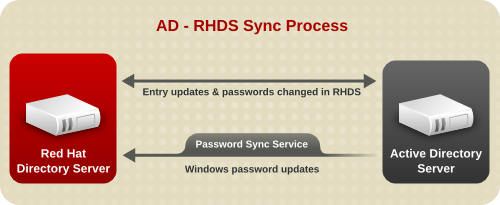Chapter 8. Designing Synchronization
An important factor to consider while conducting the site survey for an existing site (Section 2.3, “Performing a Site Survey”) is to include the structure and data types of Active Directory directory services. Through Windows Sync, an existing Windows directory service can be synchronized and integrated with the Directory Server, including creating, modifying, and deleting Windows accounts on the Directory Server or, oppositely, the Directory Server accounts on Windows. This provides an efficient and effective way to maintain directory information integrity across directory services.
8.1. Windows Synchronization Overview
Copy linkLink copied to clipboard!
The synchronization process is analogous to the replication process: it is enabled by a plug-in and configured and initiated through a synchronization agreement, and a record of directory changes is maintained and updates are sent according to that log.
There are two parts to the complete Windows Synchronization process:
- User and Group Sync. As with multi-supplier replication, user and group entries are synchronized through a plug-in, which is enabled by default. The same changelog that is used for multi-supplier replication is also used to send updates from the Directory Server to the Windows synchronization peer server as an LDAP operation. The server also performs LDAP search operations against its Windows server to synchronize changes made to Windows entries to the corresponding Directory Server entry.
- Password Sync. This application captures password changes for Windows users and relays those changes back to the Directory Server over LDAPS. It must be installed on the Active Directory machine.
Figure 8.1. The Sync Process
8.1.1. Synchronization Agreements
Copy linkLink copied to clipboard!
Synchronization is configured and controlled by one or more synchronization agreements . These are similar in purpose to replication agreements and contain a similar set of information, including the host name and port number for the Windows server and the subtrees being synchronized. The Directory Server connects to its peer Windows server using LDAP or LDAP over TLS to both send and receive updates.
A single Windows subtree is synchronized with a single Directory Server subtree, and vice versa. Unlike replication, which connects databases, synchronization is between suffixes, parts of the directory tree structure. Therefore, when designing the directory tree, consider the Windows subtrees that should be synchronized with the Directory Server, and design or add corresponding Directory Server subtrees. The synchronized Windows and Directory Server suffixes are both specified in the synchronization agreement. All entries within the respective subtrees are available for synchronization, including entries that are not immediate children of the specified suffix.
Note
Any descendant container entries need to be created separately on the Windows server by an administrator; Windows Sync does not create container entries.
8.1.2. Changelogs
Copy linkLink copied to clipboard!
The Directory Server maintains a changelog, a database that records modifications that have occurred. The changelog is used by Windows Sync to coordinate and send changes made to the Windows synchronization peer server. Changes to entries in the Windows server are found by using Active Directory's Dirsync search feature. Because there is no changelog on the Active Directory side, the Dirsync search is issued, by default, periodically every five minutes. Using Dirsync ensures that only those entries that have changed since the previous search are retrieved.
